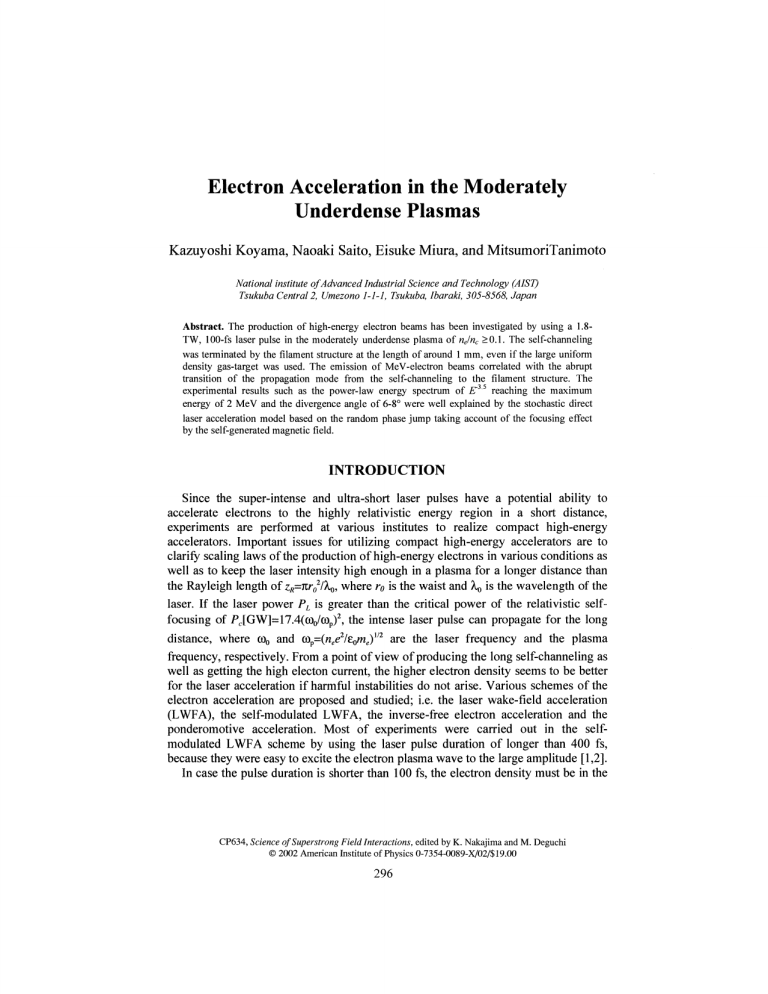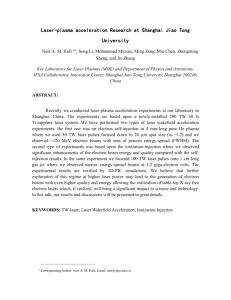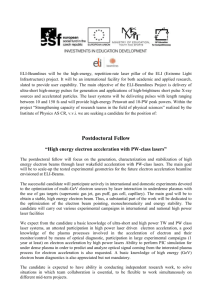Electron Acceleration in the Moderately Underdense Plasmas

Electron Acceleration in the Moderately
Underdense Plasmas
Kazuyoshi Koyama, Naoaki Saito, Eisuke Miura, and MitsumoriTanimoto
National institute of Advanced Industrial Science and Technology (AIST)
Tsukuba Central 2, Umezono 1-1-1, Tsukuba, Ibaraki, 305-8568, Japan
Abstract. The production of high-energy electron beams has been investigated by using a 1.8-
TW, 100-fs laser pulse in the moderately underdense plasma of njn c
>0.1. The self-channeling was terminated by the filament structure at the length of around 1 mm, even if the large uniform density gas-target was used. The emission of MeV-electron beams correlated with the abrupt transition of the propagation mode from the self-channeling to the filament structure. The experimental results such as the power-law energy spectrum of E~
3 5
reaching the maximum energy of 2 MeV and the divergence angle of 6-8° were well explained by the stochastic direct laser acceleration model based on the random phase jump taking account of the focusing effect by the self-generated magnetic field.
INTRODUCTION
Since the super-intense and ultra-short laser pulses have a potential ability to accelerate electrons to the highly relativistic energy region in a short distance, experiments are performed at various institutes to realize compact high-energy accelerators. Important issues for utilizing compact high-energy accelerators are to clarify scaling laws of the production of high-energy electrons in various conditions as well as to keep the laser intensity high enough in a plasma for a longer distance than the Rayleigh length of z
R
=nr
02
/h
0
, where TQ is the waist and X
0
is the wavelength of the laser. If the laser power P
L
is greater than the critical power of the relativistic selffocusing of P c
[GW]=17.4(Q)
0
/a) p
)
2
, the intense laser pulse can propagate for the long distance, where co
0
and co p
=(rc e e
2
/£
0 ra e
)
1/2
are the laser frequency and the plasma frequency, respectively. From a point of view of producing the long self-channeling as well as getting the high electon current, the higher electron density seems to be better for the laser acceleration if harmful instabilities do not arise. Various schemes of the electron acceleration are proposed and studied; i.e. the laser wake-field acceleration
(LWFA), the self-modulated LWFA, the inverse-free electron acceleration and the ponderomotive acceleration. Most of experiments were carried out in the selfmodulated LWFA scheme by using the laser pulse duration of longer than 400 fs, because they were easy to excite the electron plasma wave to the large amplitude [1,2].
In case the pulse duration is shorter than 100 fs, the electron density must be in the
CP634, Science of Super strong Field Inter actions, edited by K. Nakajima and M. Deguchi
© 2002 American Institute of Physics 0-7354-0089-X/02/$ 19.00
296
region of a moderately underdense plasma ofn e
/n c
>0.1 for exciting the plasma wave by the LWFA, where n c
is the cutoff density. However the high electron density is favorable for the relativistic self-focusing as above mentioned, it is hard to expect to accelerate electrons in the self-modulated LWFA regime because of the insufficient growth of the plasma wave. However, the high-energy electrons are actually generated in the moderately underdense plasmas [3,4]. In this paper, we present experiments on the high-energy electron beam emission from moderately underdense plasmas as well as the theoretical consideration on the stochasticdirect laser acceleration of electrons.
EXPERIMENTS
TW-pulses delivered by a Thsapphire laser were focused on the supersonic pulsed gas-jets by using an F/5.5 off-axis parabolic mirror. The peak power and the duration of the laser pulse were 1.8 TW and 100 fs (FWHM), respectively. The gas jet formed a sharply bounded uniform density near the nozzle. The number density of the neutral gas was 3.4 xlO
19
cm"
3
at the reservoir pressure of 800 kPa, which corresponds to the electron density of 2.7 xlO
20
cm"
3
for Ar
8+
-plasma. The average intensity in a focal spot of 12-15|iim in a vacuum was 7x 10
17
W/cm
2
, which was surrounded by a large halo of approximately 10
15
W/cm
2
. The laser pulse was focused on the surface of the gas jet. For diagnosing the laser propagation in the plasma, an ultra-fast shadowgraphy and a side scattering of the TW laser pulse were recorded. In the scattering experiment, the direction of the polarization of the TW laser beam was perpendicular to the direction of the observer. A spatial resolution of these optical diagnostic systems was
10 \im.
A typical shadowgraph of the plasma is shown in Fig. 1(«), which was taken just after the TW laser pulses passed through the gas jet. The smooth channeling around 1te^rr^m^wrm^**^
J0f
!:!|tf:f in \/acuum
(a)
(*) iiiii
Gas J0I
1 mm
FIGURE 1. The typical shadowgraph (a) and the image of the side-scattering(6) of the plasmas produced in the gas-target of the quasi-uniform density profile.
297
|io
13 lid
2
0 1.6TW -N2:8.4bar
• 1.5TW
• 1.0 TW
D 0.5 TW
X 1.6 TW -Me: 8.0 bar
Jio
9
V fio
7
10
6
0.01 0.1 1 10
Electron Energy (MeV)
FIGURE 2. Energy spectrum of electron beams measured along the laser axis.
„„,,,,„„„.„.,,„„„.,„,,„„„„., , l
.
l
., r
,
>
0
>l
, l
S
£ xO.27
a t E l 2 3 -
.=:
3 xO.12
influence of
Hie scattering fiosi the Ibil
(a)
Angle from the laser axis (deg.)
(to
FIGURE 3 (a)Electron beam shadows of SUS-bolts. (b) Measured width of penumbrae at two different configurations. Arrows indicate the influence of the scattering from the filter.
mm long was terminated by an abrupt transition of laser pulse propagation mode to a complex filamentation in the regime of the high electron density of n e
> 2xl0
19
cm"
3
as well as the high laser power of PL > 1 TW. A distance to the transition of the propagation mode of 1.2-0.8 mm was scaled as P
L
~
QA n e
'°s
. The time-integrated sidescattering image of the TW laser beam is shown in Fig. l(b). In the side scattered light, no shifted component from the wavelength of the laser was observed. The sidescattering image consisted of a slender, pale and straight filament and a following extremely bright region, which corresponded to the smooth channeling and the part of the complex filamentation in the shadowgraph, respectively. In case that the direction of the polarization of the TW laser was parallel to the direction of the observer, the scattered light from the slender part became very weak; the intensity of the bright part
298
was unchanged, however. In the region of the low laser power or the low electron density, neither the transition to the complex filamentation nor the bright scattering was observed. The smooth channel of the constant diameter suggests that the intense lasepulse is guided by the relativistic self-focusing, since the laser power of 1.8 TW in the gas density of 3.4xl0
19
cm"
3
corresponds to approximately 5 times higher than the critical power of the relativistic self-guiding (P c
) for a fully ionized helium plasma
(19P c forAr
8+
-plasma).
Angular distributions of high-energy electron beams were measured by using a scintillator-film detector. The energy spectrum of the electron beam was measured by using an electron energy analyzer in the forward direction along the main laser beam.
The quality of the electron beam was evaluated by measuring widths of penumbrae of the thick materials placed at various angles from the laser axis. Emissions of highenergy electron beams seemed to coincied with the appearance of the transition feature of the laser pulse propagation. A divergence of the high-energy eletron beam was 6-
8°FWHM. The direction of the electron beam fluctuated within the angle of 15-
20°FWHM. around the optical axis of the laser from shot to shot. The maximum number of the high-energy electrons was estimated to be (1.3+0.6)xlO n
/sr/shot from the electron current measured by using a Faraday cup. Energy spectra seem to have a power-law of E~
3 5
reaching the maximum electron energy of 2 MeV as shown in Fig.2.
Slopes of spectra seem to be unchanged by the laser power. The electron-beam shadows of SUS-bolts placed at various directions and measured widths of penumbrae are shown in Fig. 3(a) and Fig. 3(Z>), respectively. One can deduce that the shape of the electron source after subtracting the effect of the blurring due to the electron scattering from the Al-foil which is indicated by arrows in Fig. 3(Z>). A radius of the source is smaller than a resolving power of 0.1 mm. The source length is estimated to be approximately 4 mm, although the plasma length is 3 mm.
DISCUSSION
In the moderately underdense plasma, it seems that electrons are hardly accelerated by the self-modulated LWFA, because the significantly large difference of phase velocities between the pump (~l.lc) and the scattered light (~1.4<?) leads to the short dephasing length of the Raman Forward Scattering (RFS) instability of IjLim which is insufficient for exciting the plasma wave to the large amplitude, where c is the velocity of the light in the vacuum. The possibility of the direct acceleration by the oscillating electric field of the laser is also excluded, because the ponderomotive potential (the kinetic energy of the quivering of the electron) is approximately 80 keV at the laser intensity of 7x10
17
W/cm
2
(<30=0.65), where do is the normalized vector potential of the field. Although the experiments were performed in the density region of njn c
> 0.2 as well as at the weakly relativistic intensity region of #o<l, the highenergy electron beam (>MeV) was observed coinciding with the appearance of the
299
laser propagation changed from the smooth propagation to the complex filamentation as above mentioned. These features suggest the causality between the electron acceleration and the complex filamentation in the plasma. The merging and the splitting of the plasma filaments might cause the phase-disturbance of the oscillating field.
As one of the potential mechanisms, we have studied the stochastic direct laser acceleration that can efficiently accelerate the electrons to the substantially high energy at the weakly relativistic laser intensity. The electron motion can be analyzed by calculating the normalized vector potential of the laser field a(i) even if the electric fields £(T) are discontinuous, since the vector potential is expressed by the integral of the electric filed as
, where dr= dt - dz/c = (l-fi z
)dt, fl z
= v z
/c, and z is the direction of the laser propagation.
For electrons initially at rest, there is no net energy transfer from the laser field to these electrons after leaving the laser pulse. However, if the disturbances are introduced into the laser field, electrons can gain energy from the laser field. We modeled these disturbances by the stochastic phase jumps of the coherently oscillating electromagnetic fields. The model shows the maximum kinetic energy of the electron of E max
=y max
-l=2m
2 ao
2
in case the width of the phase jump A(/)(T) are randomly distributed, where m is the number of the phase jump. Since the physics of phasedisturbance of the oscillating field has not been understood, we assume the phase jump obeys the probability function of/?(z)=(l/A)exp(-z//l), where A is the mean free path of
2 3 5 1 0
Emetic Energy ;
0)
20
FIGURE 4. The momentum distribution (a) and the energy distribution (b) of 4000 electrons accelerated in the stochastic laser field. The average number of phase jump is mo=3. The selfgenerated magnetic field is taken into account.
300
the phase jump (mean width of the phase jump). The mean number of the phase jump is defined to be m^Zplk, where z p
is the length of the plasma filament. As shown in
Fig. 4(Z>), the energy spectrum was well reproduced in case mo=3, which was calculated for 4000 electrons.
The simply deduced divergence angle of the electron beam from the relation between the transverse and the longitudinal momentum gained by the direct acceleration is 9 =tan"
1
(p*//>z)
=
tan"
1
(2/(y-l))
1/2
. This value of 9 -40°, which corresponds to the observed energy in our experiment, is mach larger than the observed divergence angle of 6-8°. In order to explain the cause of the collimated electron beam which was observed by the experiments, we supposed the electron beam was focused by the magnetic field produced by the beam. By introducing the magnetic field strength of 2MG produced by drifting electron-clouds of a relatively low energy was taken account, the beam divergence of experimentally obtained is well reproduced as shown in Fig. 4(a).
In our experiment, the fine structure followed by the abrupt transition of the propagation of the plasma was recorded by the optical shadowgraph, in spite of the longer duration of the probe pulse of 100 fs than an oscillation period of the electron plasma wave of approximately 10 fs. Hydrodynamic motion of ions is also neglgible in the duration of the probe pulse. This feature suggests that the degree of ionization in the plasma is modulated by growing hot spots in the focal spot, which might cause the phase jumps on the electron motions by merging and splitting of the filaments.
CONCLUSION
We have investigated the production of high-energy electron beams in the moderately underdense plasma of njn c
>0.1, The emission of MeV-electron beams correlated with the abrupt transition of the propagation mode from the smooth channeling to the filament structure. The self-channeling was terminated at the length of around 1 mm, even if the uniform density gas-target was used.
The experimentally observed power-law energy spectrum of E'
3 5
reaching the maximum energy of 2 MeV as well as the divergence angle of 6-8° were well explained by the stochastic direct laser acceleration model introducing the selfgenerated magnetic field.
ACKNOWLEDGMENTS
A part of this study was financially supported by the Budget for Nuclear Research of the MEXT, based on the screening and counseling by the Atomic Energy
Commission and the Advanced Compact Accelerator Development Project supported by the MEXT.
301
REFERENCES
1. A.Modena, Z.Najmudin, A.E.Dangor, C.E.Clyton, K.A.Marsh, and C.Joshi, IEEE Trans. on Plasma Sci. 24
(1996)289-295.
2. R.Wagner, S.-Y.Chen, A.Maksimchuk, and D.Umstadter, Phys.Rev.Lett. 78 (1997) 3125-3128.
3. K.Koyama, N.Saito, M.Tanimoto, "Production of MeV electrons in a gas-jet target," in High-Power Lasers in
Energy Engineering -1999, edited by K.mima, G.L.Kulcinski and W.Hogan, Proc. of SPIE, 1999, Vol.3886, pp.76-80.
4. C.Gahn, G.D.Tsakiris, A.Pukhov, J.Meyer-ter-Vehn, G.Pretzler, P.Thirolf, D.Hobs, and K.J.Witte,
Phys.Rev.Lett. 83 (1999) 4772-44775.
302




